苏教版六年级英语上常用动词过去式归纳总结
- 格式:doc
- 大小:44.50 KB
- 文档页数:1

苏教版六年级英语上册知识点集团标准化办公室:[VV986T-J682P28-JP266L8-68PNN]U n i t1T h e k i n g’s n e w c l o t h e s一、单词/词组1.long long ago 很久以前2.new clothes 新衣服3.make new clothes for you 为你制作新衣服 make sth for sb4.show the king his new clothes给皇帝展示新衣服show sb. sth.= show sth. to sb.5.try on 试穿 try on the coat=try the coat ontry it/them on6.magic clothes 有魔力的衣服7.walk through步行穿过8.in his new clothes 穿着他的新衣服9.shout at sb. 对某人大叫ugh at sb. 对某人大笑11.look at 看….12.point at 指向…13.fit well 非常适合14.an American cowboy 一个美国牛仔15.a Scottish man 一位苏格兰人16.tell a story 讲一个故事17.say a/one sentence 说一句话18.on the mountain 在山上19.the next sentence 下一句话20.live in the house 住在房子里21.tell the boy a story 给这个男孩讲一个故事 tell sb. sth.22.it is one’s turn 某人的机会23.think hard 努力思考24.have to 不得不 have to do sth.25.in front of 在….前面(外部) in the front of 在…前面(内部)26.walk by 路过27.be nice to sb. 对某人好28.look after 照顾29.turn into 变成二、句型1.Long long ago, there was a king. 很久很久以前,有一位国王。
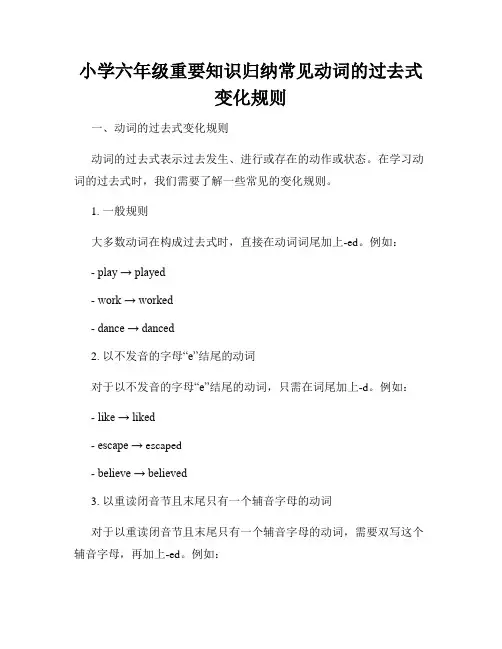
小学六年级重要知识归纳常见动词的过去式变化规则一、动词的过去式变化规则动词的过去式表示过去发生、进行或存在的动作或状态。
在学习动词的过去式时,我们需要了解一些常见的变化规则。
1. 一般规则大多数动词在构成过去式时,直接在动词词尾加上-ed。
例如:- play → played- work → worked- dance → danced2. 以不发音的字母“e”结尾的动词对于以不发音的字母“e”结尾的动词,只需在词尾加上-d。
例如:- like → liked- escape → escaped- believe → believed3. 以重读闭音节且末尾只有一个辅音字母的动词对于以重读闭音节且末尾只有一个辅音字母的动词,需要双写这个辅音字母,再加上-ed。
例如:- stop → stopped- plan → planned- drop → dropped4. 以“辅音字母+y”结尾的动词对于以“辅音字母+y”结尾的动词,将“y”变成“i”,再加上-ed。
例如:- study → studied- try → tried- carry → carried5. 特殊变化规则有一些动词的变化规则比较特殊,需要特别注意。
例如:- be → was (过去式变化不规则,第三人称过去式为were)- have → had- do → did- go → went二、常见动词的过去式变化下面是一些在小学六年级中常见的动词及其过去式变化:1. 动词:be(是,存在)过去式:was / were2. 动词:have(有)过去式:had3. 动词:do(做)过去式:did4. 动词:go(去)过去式:went5. 动词:see(看见)过去式:saw6. 动词:get(得到)过去式:got7. 动词:come(来)过去式:came8. 动词:eat(吃)过去式:ate9. 动词:drink(喝)过去式:drank 10. 动词:read(读)过去式:read(同形)11. 动词:write(写)过去式:wrote12. 动词:take(拿,取)过去式:took13. 动词:find(找到)过去式:found14. 动词:give(给予)过去式:gave15. 动词:say(说)过去式:said总结:动词的过去式变化规则多种多样,但掌握常见的规则和不规则变化可以帮助我们正确地使用过去式。
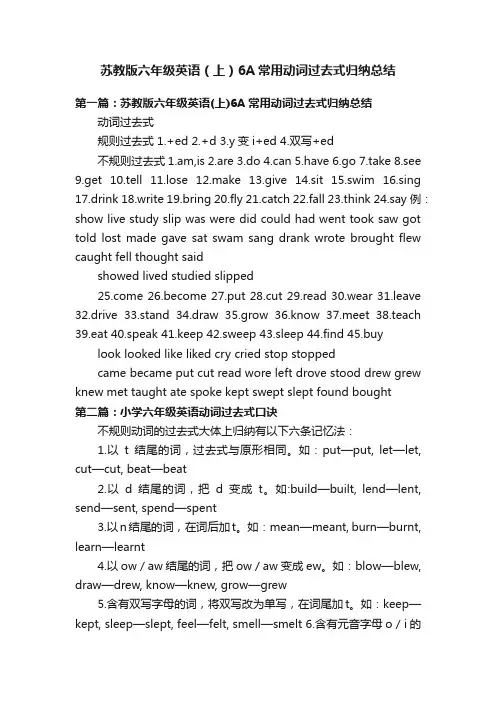
苏教版六年级英语(上)6A常用动词过去式归纳总结第一篇:苏教版六年级英语(上)6A常用动词过去式归纳总结动词过去式规则过去式 1.+ed 2.+d 3.y变i+ed 4.双写+ed不规则过去式1.am,is 2.are 3.do 4.can 5.have 6.go 7.take 8.see 9.get 10.tell 11.lose 12.make 13.give 14.sit 15.swim 16.sing 17.drink 18.write 19.bring 20.fly 21.catch 22.fall 23.think 24.say 例:show live study slip was were did could had went took saw got told lost made gave sat swam sang drank wrote brought flew caught fell thought saidshowed lived studied slippede 26.become 27.put 28.cut 29.read 30.wear 31.leave 32.drive 33.stand 34.draw 35.grow 36.know 37.meet 38.teach 39.eat 40.speak 41.keep 42.sweep 43.sleep 44.find 45.buylook looked like liked cry cried stop stoppedcame became put cut read wore left drove stood drew grew knew met taught ate spoke kept swept slept found bought第二篇:小学六年级英语动词过去式口诀不规则动词的过去式大体上归纳有以下六条记忆法:1.以t结尾的词,过去式与原形相同。
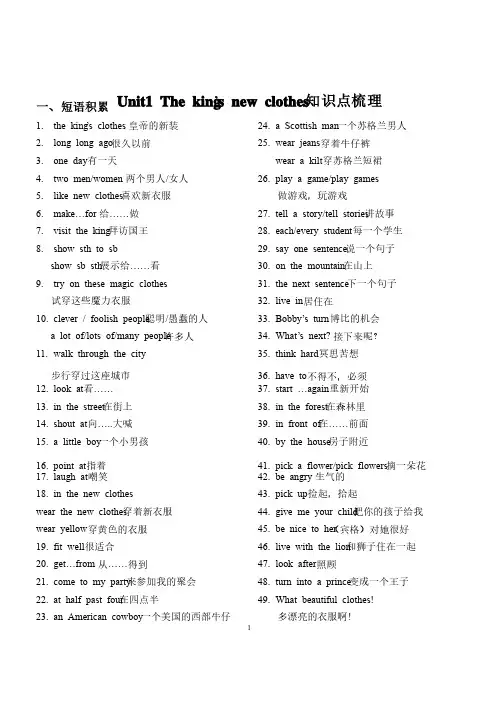
Unit1 The king’s new clothes知识点梳理一、短语积累1.the king’s clothes 皇帝的新装皇帝的新装2.long long ago很久以前很久以前3.one day有一天有一天4.two men/women 两个男人/女人女人5.like new clothes喜欢新衣服喜欢新衣服6.make…for给……做7.visit the king拜访国王拜访国王8.show sth to sb show sb sth展示给……看9.try on these magic clothes 试穿这些魔力衣服试穿这些魔力衣服10.clever / foolish people聪明聪明/愚蠢的人愚蠢的人 a lot of/lots of/many people许多人许多人11.walk through the city 步行穿过这座城市步行穿过这座城市12.look at看……13.in the street在街上在街上在街上14.shout at向…..大喊大喊15.a little boy一个小男孩一个小男孩16.point at指着指着ugh at嘲笑嘲笑18.in the new clothes wear the new clothes穿着新衣服穿着新衣服穿着新衣服wear yellow穿黄色的衣服穿黄色的衣服19.fit well很适合很适合20.get…from从……得到得到e to my party来参加我的聚会来参加我的聚会来参加我的聚会22.at half past four在四点半在四点半23.an American cowboy一个美国的西部牛仔一个美国的西部牛仔24.a Scottish man一个苏格兰男人一个苏格兰男人 25.wear jeans穿着牛仔裤穿着牛仔裤wear a kilt 穿苏格兰短裙穿苏格兰短裙穿苏格兰短裙26.play a game/play games 做游戏,玩游戏做游戏,玩游戏27.tell a story/tell stories讲故事讲故事讲故事28.each/every student每一个学生每一个学生 29.say one sentence说一个句子说一个句子30.on the mountain在山上在山上31.the next sentence下一个句子下一个句子32.live in居住在居住在33.B obby’s turn博比的机会博比的机会34.WhatWhat’’s next? 接下来呢?接下来呢?35.think hard冥思苦想冥思苦想36.have to不得不,必须不得不,必须37.start …again重新开始重新开始38.in the forest在森林里在森林里在森林里39.in front of在……前面前面40.by the house房子附近房子附近41.pick a flower/pick flowers 摘一朵花摘一朵花 42.be angry 生气的生气的43.pick up捡起,拾起捡起,拾起44.give me your child把你的孩子给我把你的孩子给我把你的孩子给我 45.be nice to her(宾格)对她很好(宾格)对她很好 46.live with the lion和狮子住在一起和狮子住在一起和狮子住在一起 47.look after照顾照顾48.turn into a prince 变成一个王子变成一个王子 49.What beautiful clothes! 多漂亮的衣服啊!多漂亮的衣服啊!1 二、重点句型、语法点拔1、there be结构在一般过去时的各种句型转换:There be结构的组成:名词短语 +方位短语. 结构的组成: There be + 名词短语名词短语(数量词+名词) (1)肯定句:肯定句:e.g.: Long long ago, there was a king. / There were a lot of people in the street. (2)否定句:在be动词was或were后+not, some要改成any. e.g.: There were some people in the street.(否定句) not any people in the street. There were n ot(3) 一般疑问句及其肯定和否定回答:一般疑问句及其肯定和否定回答:Was there a house on the mountain? e.g.: A: W as’t. B: Yes, there was. / No, there wasn(4)有关there be的特殊疑问句的问答:的特殊疑问句的问答:’s house?(针对名词短语提问) A1:What was in front of the lionB1: There were some flowers . A2: How many houses were there on the mountain?(针对数量词提问)(针对数量词提问)B2: There was one. 2、动词在一般过去时中的变化:a、be动词在一般过去时中的变化:was/were.其中Checkout time中的circle and say进行了重点操练。
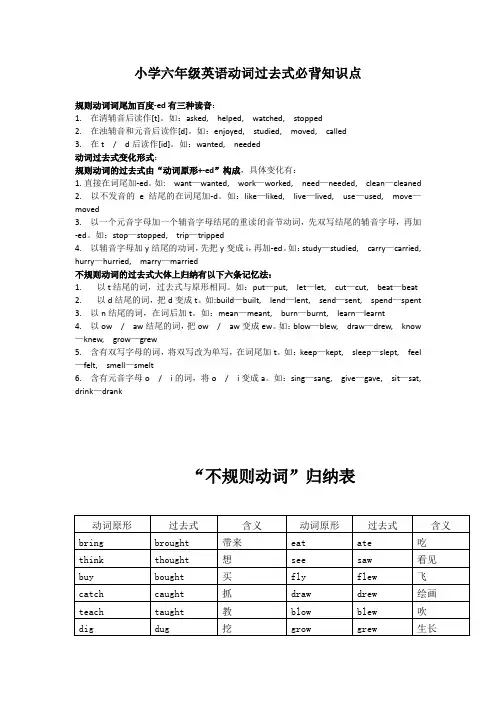
小学六年级英语动词过去式必背知识点规则动词词尾加百度-ed有三种读音:1.在清辅音后读作[t]。
如:asked,helped,watched,stopped2.在浊辅音和元音后读作[d]。
如:enjoyed,studied,moved,called3.在t/d后读作[id]。
如:wanted,needed动词过去式变化形式:规则动词的过去式由“动词原形+-ed”构成,具体变化有:1.直接在词尾加-ed。
如:want—wanted,work—worked,need—needed,clean—cleaned2.以不发音的e结尾的在词尾加-d。
如:like—liked,live—lived,use—used,move—moved3.以一个元音字母加一个辅音字母结尾的重读闭音节动词,先双写结尾的辅音字母,再加-ed。
如:stop—stopped,trip—tripped4.以辅音字母加y结尾的动词,先把y变成i,再加-ed。
如:study—studied,carry—carried, hurry—hurried,marry—married不规则动词的过去式大体上归纳有以下六条记忆法:1.以t结尾的词,过去式与原形相同。
如:put—put,let—let,cut—cut,beat—beat2.以d结尾的词,把d变成t。
如:build—built,lend—lent,send—sent,spend—spent3.以n结尾的词,在词后加t。
如:mean—meant,burn—burnt,learn—learnt4.以ow/aw结尾的词,把ow/aw变成ew。
如:blow—blew,draw—drew,know —knew,grow—grew5.含有双写字母的词,将双写改为单写,在词尾加t。
如:keep—kept,sleep—slept,feel —felt,smell—smelt6.含有元音字母o/i的词,将o/i变成a。
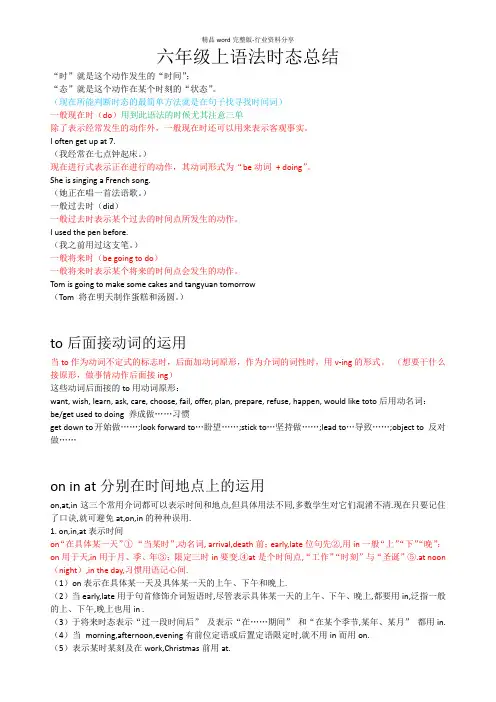
六年级上语法时态总结“时”就是这个动作发生的“时间”;“态”就是这个动作在某个时刻的“状态”。
(现在所能判断时态的最简单方法就是在句子找寻找时间词)一般现在时(do)用到此语法的时候尤其注意三单除了表示经常发生的动作外,一般现在时还可以用来表示客观事实。
I often get up at 7.(我经常在七点钟起床。
)现在进行式表示正在进行的动作,其动词形式为“be动词+ doing”。
She is singing a French song.(她正在唱一首法语歌。
)一般过去时(did)一般过去时表示某个过去的时间点所发生的动作。
I used the pen before.(我之前用过这支笔。
)一般将来时(be going to do)一般将来时表示某个将来的时间点会发生的动作。
Tom is going to make some cakes and tangyuan tomorrow(Tom 将在明天制作蛋糕和汤圆。
)to后面接动词的运用当to作为动词不定式的标志时,后面加动词原形,作为介词的词性时,用v-ing的形式。
(想要干什么接原形,做事情动作后面接ing)这些动词后面接的to用动词原形:want, wish, learn, ask, care, choose, fail, offer, plan, prepare, refuse, happen, would like toto后用动名词:be/get used to doing 养成做……习惯get down to开始做……;look forward to…盼望……;stick to…坚持做……;lead to…导致……;object to 反对做……on in at分别在时间地点上的运用on,at,in这三个常用介词都可以表示时间和地点,但具体用法不同,多数学生对它们混淆不清.现在只要记住了口诀,就可避免at,on,in的种种误用.1. on,in,at表示时间on“在具体某一天”①“当某时”,动名词, arrival,death前;early,late位句先②,用in一般“上”“下”“晚”;on用于天,in用于月、季、年③;限定三时in要变.④at是个时间点,“工作”“时刻”与“圣诞”⑤.at noon (night),in the day,习惯用语记心间.(1)on表示在具体某一天及具体某一天的上午、下午和晚上.(2)当early,late用于句首修饰介词短语时,尽管表示具体某一天的上午、下午、晚上,都要用in,泛指一般的上、下午,晚上也用in .(3)于将来时态表示“过一段时间后”及表示“在……期间”和“在某个季节,某年、某月”都用in. (4)当morning,afternoon,evening有前位定语或后置定语限定时,就不用in而用on.(5)表示某时某刻及在work,Christmas前用at.2. 表示地点、场所、位置等,注意以下用法:(1) 表示某一点位置,用at。
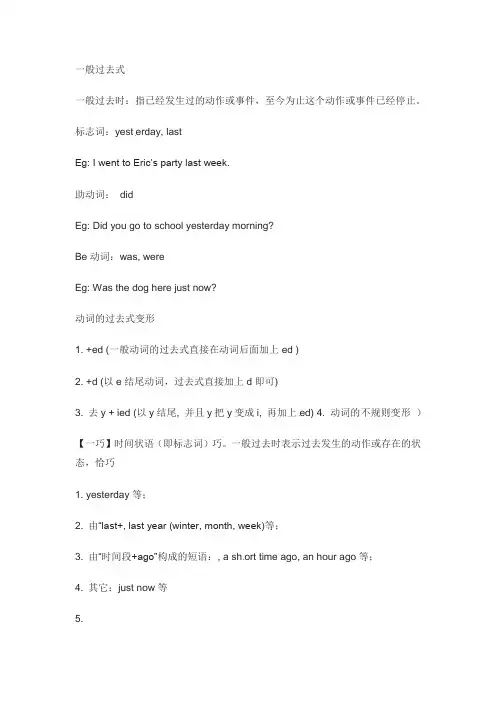
一般过去式一般过去时:指已经发生过的动作或事件,至今为止这个动作或事件已经停止。
标志词:yest erday, lastEg: I went to Eric’s party last week.助动词:didEg: Did you go to school yesterday morning?Be动词:was, wereEg: Was the dog here just now?动词的过去式变形1. +ed (一般动词的过去式直接在动词后面加上ed )2. +d (以e结尾动词,过去式直接加上d即可)3. 去y + ied (以y结尾, 并且y把y变成i, 再加上ed)4. 动词的不规则变形)【一巧】时间状语(即标志词)巧。
一般过去时表示过去发生的动作或存在的状态,恰巧1. yesterday等;2. 由“last+, last year (winter, month, week)等;3. 由“时间段+ago”构成的短语:, a sh ort time ago, an hour ago等;4. 其它:just now等5.(1主语+宾语或表语。
(2a.主语t +动词原形+宾语。
(did + not =didn't)exercises yesterday.b.主语+wasn’t/weren’t +表语。
(was + not = wasn't were + not = weren't) He wasn't an English teacher tenyears ago.(3)一般过去时的一般疑问句:a.Did +主语+动词原形+宾语?Did you study English in 1990?肯定回答用“Yes, 主语+did.”;否定回答用“No,主语+didn‟t.”。
b.Was/Were + 主语+表语?Was he a pupil five years ago ?肯定回答用“Yes, 主语+was/were.”;否定回答用“No,主语+wasn't/weren't.”。
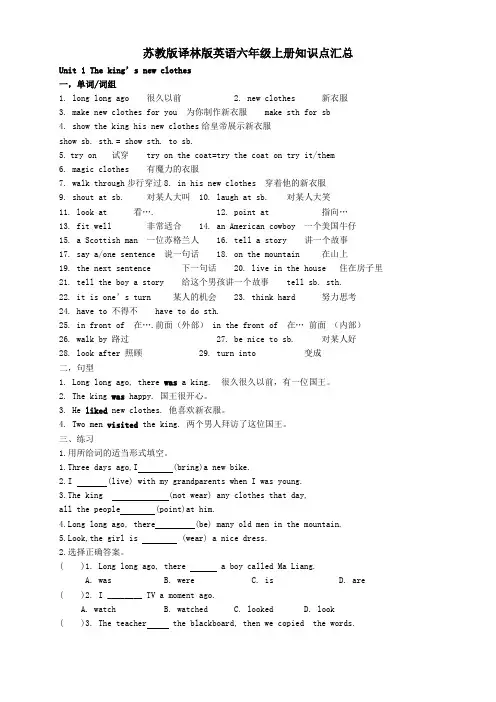
苏教版译林版英语六年级上册知识点汇总Unit 1 The king’s new clothes一,单词/词组1. long long ago 很久以前2. new clothes 新衣服3. make new clothes for you 为你制作新衣服 make sth for sb4. show the king his new clothes给皇帝展示新衣服show sb. sth.= show sth. to sb.5.try on 试穿try on the coat=try the coat on try it/them6. magic clothes 有魔力的衣服7. walk through步行穿过8. in his new clothes 穿着他的新衣服9. shout at sb. 对某人大叫10. laugh at sb. 对某人大笑11. look at 看…. 12. point at 指向…13. fit well 非常适合14. an American cowboy 一个美国牛仔15. a Scottish man 一位苏格兰人16. tell a story 讲一个故事17. say a/one sentence 说一句话18. on the mountain 在山上19. the next sentence 下一句话20. live in the house 住在房子里21. tell the boy a story 给这个男孩讲一个故事 tell sb. sth.22. it is one’s turn 某人的机会23. think hard 努力思考24. have to 不得不 have to do sth.25. in front of 在….前面(外部) in the front of 在…前面(内部)26. walk by 路过27. be nice to sb. 对某人好28. look after 照顾29. turn into 变成二,句型1. Long long ago, there was a king. 很久很久以前,有一位国王。
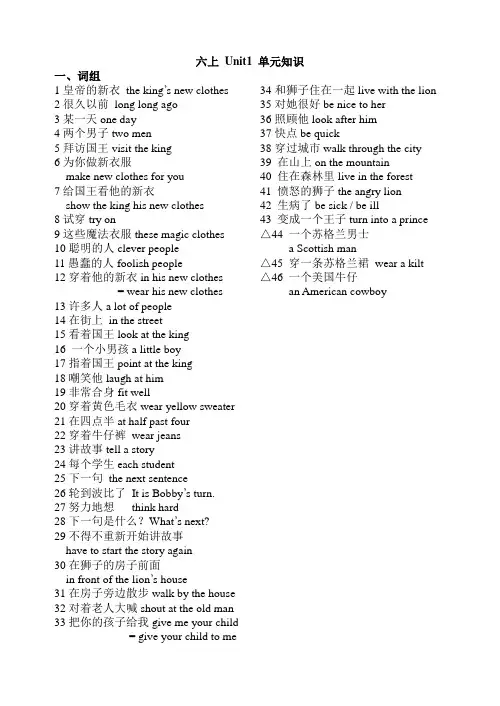
六上Unit1 单元知识一、词组1皇帝的新衣the king’s new clothes 2很久以前long long ago3某一天one day4两个男子two men5拜访国王visit the king6为你做新衣服make new clothes for you7给国王看他的新衣show the king his new clothes8试穿try on9这些魔法衣服these magic clothes 10聪明的人clever people11愚蠢的人foolish people12穿着他的新衣in his new clothes= wear his new clothes 13许多人a lot of people14在街上in the street15看着国王look at the king16 一个小男孩a little boy17指着国王point at the king18嘲笑他laugh at him19非常合身fit well20穿着黄色毛衣wear yellow sweater 21在四点半at half past four22穿着牛仔裤wear jeans23讲故事tell a story24每个学生each student25下一句the next sentence26轮到波比了It is Bobby’s turn.27努力地想think hard28下一句是什么?What’s next?29不得不重新开始讲故事have to start the story again30在狮子的房子前面in front of the lion’s house31在房子旁边散步walk by the house 32对着老人大喊shout at the old man 33把你的孩子给我give me your child= give your child to me 34和狮子住在一起live with the lion 35对她很好be nice to her36照顾他look after him37快点be quick38穿过城市walk through the city39 在山上on the mountain40 住在森林里live in the forest41 愤怒的狮子the angry lion42 生病了be sick / be ill43 变成一个王子turn into a prince △44 一个苏格兰男士a Scottish man△45 穿一条苏格兰裙wear a kilt △46 一个美国牛仔an American cowboy二、句型1. Long long ago, there was a king. 很久以前,有以为国王。
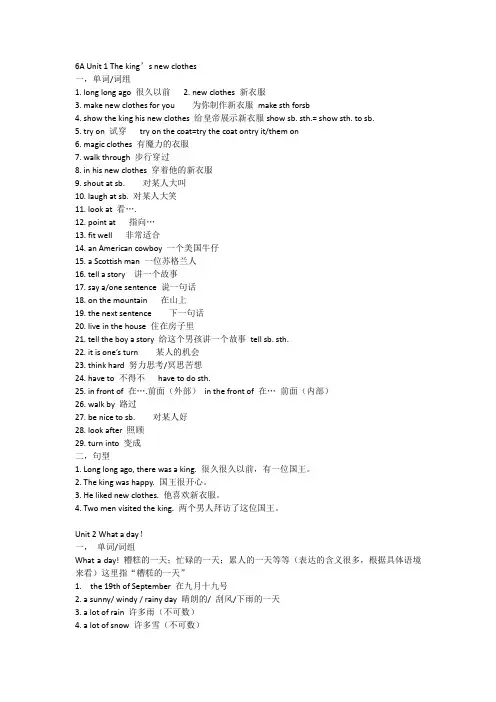
6A Unit 1 The king’s new clothes一,单词/词组1. long long ago 很久以前2. new clothes 新衣服3. make new clothes for you 为你制作新衣服make sth forsb4. show the king his new clothes 给皇帝展示新衣服show sb. sth.= show sth. to sb.5. try on 试穿try on the coat=try the coat ontry it/them on6. magic clothes 有魔力的衣服7. walk through 步行穿过8. in his new clothes 穿着他的新衣服9. shout at sb. 对某人大叫10. laugh at sb. 对某人大笑11. look at 看….12. point at 指向…13. fit well 非常适合14. an American cowboy 一个美国牛仔15. a Scottish man 一位苏格兰人16. tell a story 讲一个故事17. say a/one sentence 说一句话18. on the mountain 在山上19. the next sentence 下一句话20. live in the house 住在房子里21. tell the boy a story 给这个男孩讲一个故事tell sb. sth.22. it is one’s turn 某人的机会23. think hard 努力思考/冥思苦想24. have to 不得不have to do sth.25. in front of 在….前面(外部)in the front of 在…前面(内部)26. walk by 路过27. be nice to sb. 对某人好28. look after 照顾29. turn into 变成二,句型1. Long long ago, there was a king. 很久很久以前,有一位国王。
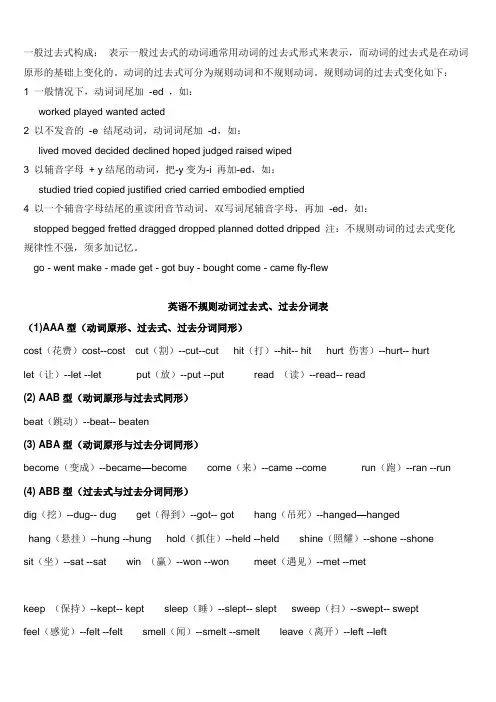
一般过去式构成:表示一般过去式的动词通常用动词的过去式形式来表示,而动词的过去式是在动词原形的基础上变化的。
动词的过去式可分为规则动词和不规则动词。
规则动词的过去式变化如下:1 一般情况下,动词词尾加-ed ,如:worked played wanted acted2 以不发音的-e 结尾动词,动词词尾加-d,如:lived moved decided declined hoped judged raised wiped3 以辅音字母+ y结尾的动词,把-y变为-i 再加-ed,如:studied tried copied justified cried carried embodied emptied4 以一个辅音字母结尾的重读闭音节动词,双写词尾辅音字母,再加-ed,如:stopped begged fretted dragged dropped planned dotted dripped 注:不规则动词的过去式变化规律性不强,须多加记忆。
go - went make - made get - got buy - bought come - came fly-flew英语不规则动词过去式、过去分词表(1)AAA型(动词原形、过去式、过去分词同形)cost(花费)cost--cost cut(割)--cut--cut hit(打)--hit-- hit hurt 伤害)--hurt-- hurtlet(让)--let --let put(放)--put --put read (读)--read-- read(2) AAB型(动词原形与过去式同形)beat(跳动)--beat-- beaten(3) ABA型(动词原形与过去分词同形)become(变成)--became—become come(来)--came --come run(跑)--ran --run (4) ABB型(过去式与过去分词同形)dig(挖)--dug-- dug get(得到)--got-- got hang(吊死)--hanged—hangedhang(悬挂)--hung --hung hold(抓住)--held --held shine(照耀)--shone --shonesit(坐)--sat --sat win (赢)--won --won meet(遇见)--met --metkeep (保持)--kept-- kept sleep(睡)--slept-- slept sweep(扫)--swept-- sweptfeel(感觉)--felt --felt smell(闻)--smelt --smelt leave(离开)--left --leftbuild(建设)--built --built lend(借出)--lent --lent send (传送)--sent-- sentspend(花费)--spent --spent lose (丢失)--lost --lost burn (燃烧)--burnt-- burntlearn(学习)--learnt --learnt mean(意思是)--meant --meant catch(抓住)--caught --caught teach(教)--taught-- taught bring(带来)--brought-- brought fight (战斗)--fought --fought buy(买)--bought-- bought think(想)--thought --thought hear (听见)--heard --heardsell(卖)--sold --sold tell(告诉)--told-- told say(说)--said-- saidfind(找到)--found --found have/has(有)--had --had make(制造)--made --made stand(站)--stood --stood understand明白--understood --understood(5) ABC型(动词原形、过去式与过去分词三者不同形)begin(开始)--began-- begun drink(喝)--drank --drunk ring(铃响)--rang-- rungsing (唱)--sang --sung swim(游泳)--swam --swum blow(吹)--blew-- blowndraw(画)--drew --drawn fly(飞)--flew --flown grow(生长)--grew --grownknow(知道)--knew-- known throw(投掷)--threw-- thrown show(出示)--showed --shown break(打破)--broke --broken choose(选择)--chose-- chosen wake(醒)--woke --wokeforget(忘记)--forgot-- forgotten (forgot) speak(说,讲)--spoke --spokendrive(驾驶)--drove --driven eat(吃)--ate --eaten fall(落下)--fell-- fallengive(给)--gave-- given rise(升高)--rose --risen take(取)--took --takenmistake(弄错)--mistook-- mistaken ride(骑)--rode --ridden write(写)--wrote-- written do(做)--did --done go(去)--went-- gone lie(平躺)--lay --lainsee(看见)--saw -- seen wear(穿)wore worn be ( am, is, are )(是)--was, were --been。
苏教版译林六年级英语上册知识点归纳6上Unit1 The king’s new clothes一、时态一般过去时:表示过去发生的动作、情况或存在的状态。
时间决定时态,注意句子中的时间副词。
一般过去时标志性时间副词有:last(上一个)…, …ago, just now(刚才), yesterday(昨天),one day, this morning....以及具体表示过去时间的短语.(On Friday, in 2019…)Mike was happy yesterday.Your brother was at home just now.过去的状态They were here a moment agoHelen went to Beijing last year.They cooked food yesterday. 过去的行为She flew kites two days ago.课本例句:One day,two men visited the king.1. 表示一般过去时的句式有两种:1)肯定句:主语+be动词过去式(was, were)+其他否定句:主语+be动词过去式(was, were)+not+其他一般疑问句:Be动词过去式(was, were) +主语+其他?如:I was tired yesterday. I was not tired yesterday. I wasn’t tired yesterday.Were you tired yesterday? Yes, I was. No, I wasn’t.We were in the park last weekend. We were not in the park last weekend.Were you in the park last weekend?Yes, we were. No, we weren’t.注意:单数was, 复数were, 不可数名词作主语,看成单数用was。
六年级英语重点单词过去式过去式(Past tense)是英语语法中的一个重要概念。
在六年级英语学习中,学生们需要掌握一系列常见动词的过去式形式。
过去式是表示过去发生的动作、事情或状态的形式。
以下将详细介绍几个常见的六年级英语重点单词的过去式形式。
1. go – went"go"意思是“去”。
它的过去式形式是"went"。
例如:I went to the park yesterday.(我昨天去了公园。
)2. eat – ate"eat"意思是“吃”。
它的过去式形式是"ate"。
例如:She ate an apple for breakfast.(她早餐吃了一个苹果。
)3. drink – drank"drink"意思是“喝”。
它的过去式形式是"drank"。
例如:They drank some waterafter playing soccer.(他们踢完足球后喝了些水。
)4. see – saw"see"意思是“看到”。
它的过去式形式是"saw"。
例如:He saw a bird in the tree.(他在树上看到了一只鸟。
)5. do – did"do"意思是“做”。
它的过去式形式是"did"。
例如:We did our homework together.(我们一起做作业。
)6. have – had"have"意思是“有”。
它的过去式形式是"had"。
例如:She had a great time at the party.(她在派对上过得很开心。
)7. make – made"make"意思是“制作”。
它的过去式形式是"made"。
六年级过去式总结一;规则动词的过去式形式1.stay---stayed (stayed at home) 待在家2;watch---watched (watched TV) 看电视3.clean---cleaned (cleaned room) 打扫房间4;wash---washed (washed clothes) 洗衣服5;cook---cooked 做饭6;listen---listened (listened to music) 听音乐7;want---wanted (wanted to) 想要;;;;8;play---played (played football/ played the pipa) 踢足球/ 弹琵琶9;like---liked 喜欢;;;;;10;visit---visited (visited grandparents) 看望祖父母11;live---lived 居住12;jump---jumped 跳13;laugh---laughed 大笑14;happen---happened (What happened?) 发生《发生了什么?》15;change---changed 改变16;look---looked 看二;不规则动词的过去式形式1;am/is---was 是2;are---were 是3;drink---drank (drank tea) 喝茶4;sleep---slept 睡觉5;read---read (read a book/ read books) 读一本书/读书6;have---had (had a cold) 感冒7;see---saw (saw a film) 看电影8;go---went(went fishing/went swimming/went camping/went shopping/went hiking) 去钓鱼/去游泳/去露营/去购物/去远足9;make---made (made the bed) 整理床铺10;get---got 到达/得到11;do---did 做,干12;don’t---didn’t 没做,没干13;fall---fell (fell off my bike) 从车子上摔下来14;hurt---hurt (hurt my foot) 伤着脚15;ride---rode (rode a horse/ rode a bike) 骑马/骑自行车16;can---could 会,能,可以;;;17;can’t---couldn’t 不会,不能,不可以;;;;18.take---took (took pictures) 照相19;eat---ate (ate fresh food) 吃新鲜的食物20;buy---bought (bought gifts) 买礼物21;run---ran 跑。
动词过去式班级:_________________ 姓名1)bite-------____________ 咬2)bring --- _____________带来3)begin---______________开始4)buy --- _______________买5)can --- _____________能够6)catch----____________ 抓住7)carry----___________ 运送8)cry--------___________ 哭9)come --- ____________ 来10)do/does --- __________做11)draw --- __________画画12)drop----___________ 滴落下13)eat --- ________ 吃14)find --- _____________找到15)fly-----_____________ 飞16)feel----_____________ 感觉17)forget --- ___________忘记18)get ---______________得到19)give --- ____________给20)go --- ____________去21)have/has --- _________做;进行22)hold-----_____________拿23)know --- ___________知道24)keep------____________保持25)leave ---_____________离开26)lose ---_____________丢失27)make --_____________制作28)meet --- ____________遇见29)run ---_____________跑30)say ---______________说31)see ---_____________看见32)send --- _____________发送33)sit--------_____________坐34)slip-----_____________滑倒35)study-----_____________学习36)sweep---_____________扫37)skate----_____________滑冰38)sleep --_____________-睡觉39)spend ---_____________度过40)stand ---_____________站立41)take ---_____________带走42)teach ---_____________教43)try----_____________尝试44)tell ---_____________告诉45)think ---_____________思考;想46)throw--- _____________扔47)wake---_____________醒来48)wear----- _____________穿49)drink --- ____________喝50)drive----_____________ 驾驶51)sing------_____________唱52)swim ---_____________游泳53)write ---_____________写54)hurt----_____________伤害疼55)read ---____________阅读56)let --- _______________让57)hit--------_____________击打58)cut ------__________剪59)put ---_____________摆;放60)stop --_____________ 停61)plan --_____________ 计划62)travel --_____________旅行63)study--_____________ 学习64)try--_____________尝试。
【最新整理,下载后即可编辑】苏教版六年级英语一般过去时复习1.一般过去时表示过去某个时间发生的动作或存在的状态,常和表示过去的时间状语连用。
一般过去时也表示过去经常或反复发生的动作。
2.Be动词在一般过去时中的变化:⑴am 和is在一般过去时中变为was。
(was not=wasn't)⑵are在一般过去时中变为were。
(were not=weren't)⑶带有was或were的句子,其否定、疑问的变化和is, am, are一样,即否定句在was或were后加not,一般疑问句把was或were 调到句首。
3.句中有行为动词的一般过去时的句子否定句:didn't +动词原形,如:Jim went home yesterday.Jim didn't go home yesterday.一般疑问句:在句首加did,句子中的动词过去式变回原形。
如:Jim went home yesterday.Did Jim go home yesterday?特殊疑问句:⑴疑问词+一般疑问句?如:Jim went home yesterday.Did Jim go home yesterday?What did Jim do yesterday?动词过去式变化规则:1.一般在动词末尾加-ed,如:pull-pulled, cook-cooked2.结尾是e加d,如:taste-tasted3.末尾是辅音字母加一个元音字母和一个辅音字母的重读闭音节,应双写末尾的辅音字母,再加-ed,如:stop-stopped4.以“辅音字母+y”结尾的,变y为i,再加-ed,如:study-studied 过去时练习写出下列动词的过去式is\am_____________ fly____________ plant____________ are ____________drink_____________ play___________ go______________ make ________does_____________ dance__________ worry___________ ask ___________taste_____________ eat____________ draw____________ put ____________throw____________ kick___________ pass____________ do __________Be动词的过去时练习(1)一、用be动词的适当形式填空1.I _______ at school just now.2.He ________ at the camp last week.3.We ________ students two years ago.4.They ________ on the farm a moment ago.5.Yang Ling ________ eleven years old last year.6.There ________ an apple on the plate yesterday.7.There ________ some milk in the fridge on Sunday.8.The mobile phone _______ on the sofa yesterday evening.二、句型转换1. It was exciting.否定句:________________________________________________一般疑问句:____________________________________________ 肯、否定回答:__________________________________________ 2. All the students were very excited.否定句:________________________________________________ 一般疑问句:____________________________________________ 肯、否定回答:__________________________________________ 3. They were in his pocket.否定句:________________________________________________一般疑问句:____________________________________________ 肯、否定回答:__________________________________________ Be动词的过去时练习(2)一、用be动词的适当形式填空1.I ______ an English teacher now.2.She _______ happy yesterday.3.They _______ glad to see each other last month.4.Helen and Nancy ________ good friends.5.The little dog _______ two years old this year.6.Look, there ________ lots of grapes here.7.There ________ a sign on the chair on Monday..8.Today _______ the second of June. Yesterday ______ the first of June. It _____ Children's Day. All the students ______ very excited.二、句型转换1. There was a car in front of the house just now.否定句:________________________________________________一般疑问句:____________________________________________ 肯、否定回答:__________________________________________ 肯、否定回答:__________________________________________三、中译英1. 我的故事书刚才还在手表旁边。